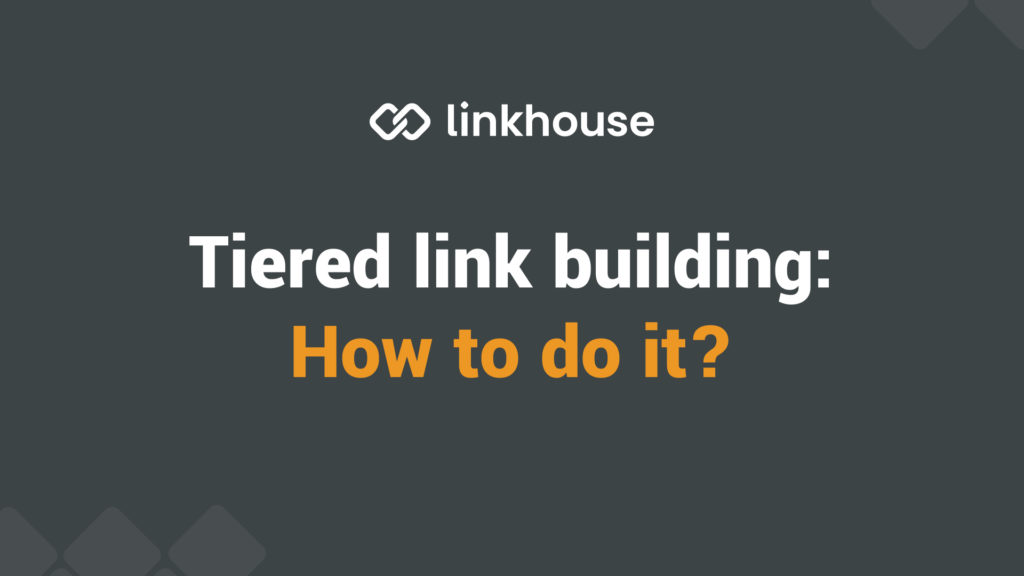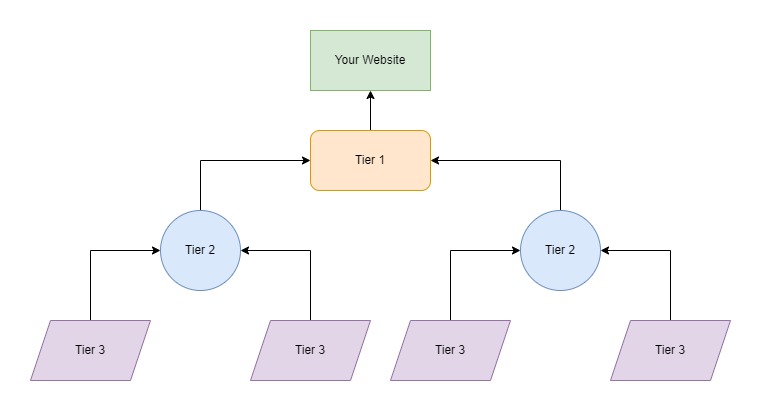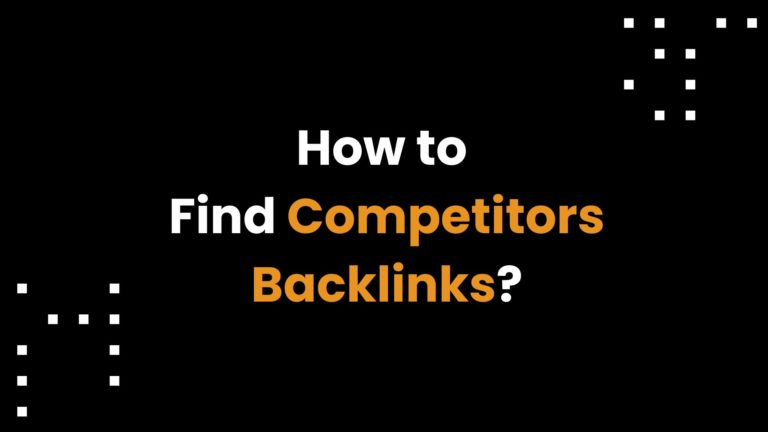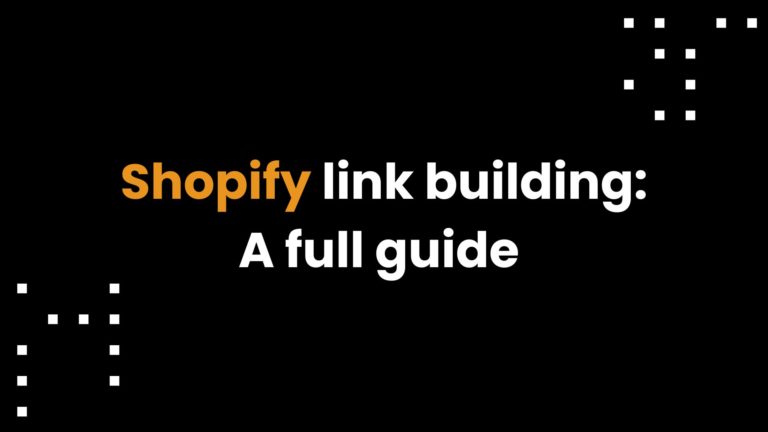What is tiered link building? This is a link building strategy that involves creating tier 1 links – ones that lead to your content, tier 2 links – ones that lead to your tier 1 links, and tier 3 links – ones that lead to your tier 2 links. It is quite beneficial for your positions in SERPs, as lower-tier links boost the power and authority of the high-tier ones.
This article explores this in more detail and explains how to introduce tiered link building effectively. Did we spark your interest? Then read on!

What Is Tiered Link Building?
Tiered link building is a backlink building strategy that involves creating multiple levels (or layers) of inbound links. The main idea behind it is to support the links that lead directly to your content with other links and, hence, increase their authority and impact on your ranks (or, as we like to call it, transfer the link juice).
The tiered link building strategy typically involves three tiers of links:
- tier 1 – linking directly to your content,
- tier 2 – linking to your tier 1 links,
- tier 3 – linking to your tier 2 links.
Take a look at the illustration below to see how it works.

How to Build a Tiered Link Building Profile
With this brief introduction behind us, let’s discuss how to create a tiered link building profile. While, in general, you just need to link to your links…it’s not as simple. Why don’t we look from the perspective of each tier?
Tier 1 Links
Tier 1 links are the most important ones. Therefore, they should be acquired from high-authority, respected websites.
How to acquire tier 1 links? Ideally, consider contacting reputable website owners or editors and convince them to publish your guest posts. This will lay the foundation for the rest of your tiered link building practices, so you should target domains that are really high in SERPs, have 80+ or 90+ domain authority scores and relevant traffic.
How to find such domains? You can get to them by applying relevant filters in our link building marketplace. This way, you’ll be able to purchase links quickly, as each of the sites will be displayed with an offer. Also, consider using our topical backlinks tool at the same time – domain authority is important, but so is topical relevance.
You should also use natural links as your tier 1s as long as they are published on reputable sites. Also, remember that tier 1 links must be top-notch in terms of content.
Tier 2 Links
Tier 2 links aren’t as crucial as tier 1 links, but they still should be high-quality. What do we mean in practice? About 50-70 domain authority scores and, obviously, topical relevance. So, how to acquire tier 2 links effectively?
We suggest getting our guest post packages for the authority strategy. This way, you will quickly acquire several tier 2 links on domains with adequate authority (you can, for example, choose only domains with 50+ or 60+ DR). However, you should remember that you don’t want to get too many tier 2 links – about 3-7 should do.
Also, be sure to diversify your tier 2 links. While getting 7 guest posts for the same keyword might be tempting, you should use different anchors and various (relevant) sources. It’s also good to utilize social media and share the links there.
Tier 3 Links
Tier 3 links are the least important, so you don’t have to pay that much attention to their quality (though you still should keep up with link building best practices). Here, you can consider using automated tools, since you simply don’t want to spend too much time finding and acquiring your tier 3 links.
However, you have to be cautious when obtaining tier 3 links – you don’t want to do it too quickly. After all, a high link velocity is a signal to Google that you might be employing spammy practices. Additionally, like in the case of tier 2 links, you want to create only a few, no more than ten, tier 3 links for each tier 2 backlink.
The Benefits of Tiered Link Building
You know what tiered link building is and how to build it with our link building platform, so let’s discuss the benefits that come with this approach. What are they? Here’s a list!
Multi-Layered Link Equity Passing Structure
With several linking layers, each of your direct links transfers more juice to your target continent. But you could technically achieve that with more backlinks, right? Well, not exactly.
The first benefit of this approach is that you can utilize each of your top-notch backlinks to a maximum, increasing their power even more through additional linking. But it’s also the fact that tier 2 and tier 3 links are often less (or even not at all) related to your initial link, which lets you transfer juice from sources that you wouldn’t be able to utilize otherwise.
Easy to Analyze Backlink Profile
Another advantage of tiered link building is that it organizes your backlink profile. This way, it’s easier to analyze your links, and they look more healthy to Google algorithms.
After all, an unnaturally looking backlink profile can be penalized by Google, and having only tier 1 links is an indication of this. That’s why, while you don’t have to apply tiered link building to every backlink you acquire, it’s good to do it, at least for some.
It’s Affordable
While top-tier links need to be of the highest quality, the further you go, the lower this need is. This means that you can acquire the same amount of link juice as you would do with a standard link building strategy for less.
Tier 3 and tier 2 links are cheaper than tier 1, so by supporting your existing tier 1 links instead of acquiring more and more of them, you can get the same results while spending significantly less on link building and using the saved resources to strengthen other elements of your SEO strategy.
Is Tiered Link Building Black Hat SEO?
One of the common fears about tiered link building is that it’s among the black hat techniques, ones that could get your site penalized by Google. But, is it really so?
It all depends on how you conduct your tiered link building strategy. In theory, your tier 1 links should be acquired naturally, and 2 tier links would typically be guest posts or social media posts, which doesn’t classify them as black hat. But, it might be different for tier 3 links.
It is possible to violate Google guidelines when acquiring tier 3 links, for instance, by:
- creating low-quality directory links,
- creating comments on forums that contain links on keywords,
- using fully-automated tools to get your links.
This is why you should opt for reliable sources even for your tier 3 links – ones that let you get your links quickly but without violating Google guidelines, such as our marketplace. This way, you can keep your tiered link building safe, avoid penalties, and harvest the benefits of this strategy.
The Takeaway
So, let’s sum this article up. What is tiered link building? It’s an approach in which you create different levels of backlinks, with the first tier linking directly to your website, the second tier to the first-tier content, and the third tier linking to the second-tier content. Is it effective? Yes, because it’s less expensive than standard strategies (as low-tier links can be of a lower quality or more diverse), it makes your backlink profile clearer and easier to analyze and helps you transfer more power to your most important content. Hence, we recommend adopting this strategy – especially since you can put it to life with the use of our link building tools!
Are you looking for other ways to acquire backlinks? Then check out our backlink gap module – a tool that will help you analyze your competitors and acquire links based on the differences quickly and effortlessly!
What are the risks of tiered link building and how to mitigate them?
Risks include potential penalties for perceived manipulative practices. Mitigation involves focusing on white hat strategies, ensuring high quality links at all tiers, and using reputable link building services to maintain a natural link profile.
How does white hat differ from black hat tiered link building?
White hat focuses on ethical practices with relevant, high-quality backlinks. Black hat uses manipulative tactics like automated services for low-quality links. White hat prioritizes value and aligns with search engine guidelines.
Why consider tiered link building in SEO strategies?
It offers structured backlinking that amplifies main content authority through layered links. Using quality-focused services ensures sustainable, risk-reduced tiered backlinks.
What is the future of tiered backlinks building in SEO?
Future trends will lean towards quality, relevance, and ethical practices, with an emphasis on services that adapt to evolving search engine algorithms while maintaining effective tiered backlinks.
How to ensure effective and safe tiered link building?
Prioritize link quality across all tiers, opt for white hat link building services, and regularly audit your link profile to maintain your site’s reputation and avoid penalties.








